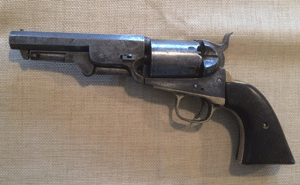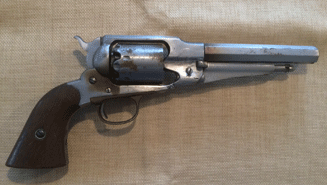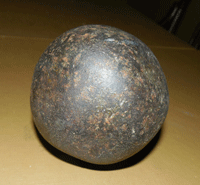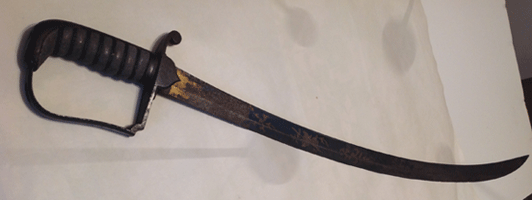|

|

Posted June 2016

|
If you have a Civil War item that you can't identify or something you want to know the value of, contact John (mail: Box 510, Acworth, GA 30101;
email John at seantiquing@go-star.com with
Civil War in the subject
line or call 770-329-4984 or 770-974-6495). John needs a good description of the item, condition, manufacturer's marks and any other markings, and photos.
Please Note: All questions MUST be accompanied with a Photo, it should not be more than 200k in file size.
|
|
|
|
Mr. Sexton, I have read and enjoyed your columns over the years and thought that I would take you up on your free appraisal offer. It involves two revolvers that were part of my father’s small collection of firearms.
The first is a Remington 1858 New Model revolver, and the holster that the gun was always in. At one time, he had the belt also. It was given to him when he was a boy (circa 1920). The gun had a damaged barrel and cylinder from some sort of misfire in its past. It had been plated with nickel. My father had begun an attempt at restoration, removing the plating and partially restoring the cylinder. He never got to either replacing or somehow repairing the otherwise shortened barrel. The intriguing part is that the grips are original and have inspection markings stamped on them—indicating Government Issue during the Civil War. My question is, is the gun of any value at all given its condition? Is that the original holster?
The second gun is a Colt .36 caliber, six-shot revolver, Model 1851. It has an unusually short barrel. Was this gun used in the Civil War? I am having trouble identifying this gun with the unusually short barrel.
|

|

|
|
A .31 caliber Colt Model 1849 revolver, $300-$600.
|
A
damaged Remington 1858 New Model revolver, $200.
|
JS: Your pistols as you stated were standard Civil War Era revolvers. Originally, the Model Remington Army had an 8-inch barrel. If it were in average "as found," good, well used, "unaltered" condition, it would average $800-$1,200 retail. As modified, the value is greatly reduced; typically in auction, similar guns bring about $200 on average. The holster is not Civil War but a much later commercial holster.
Upon closer examination of your Colt revolver that you stated originally was .36 caliber, which would have made it a Model 1851 Navy, it is actually a Model 1849 in .31 caliber. It has a flat cylinder instead of rebated as on the 1851s; those two guns otherwise have very similar profiles.
The Model 1849 pocket models came with 4-inch, 5-inch and 6-inch barrels, and this gun appears to be original with a 4-incher. Originally, there would have been a rolled cylinder scene showing a "Stage Coach Robbery" instead of a naval battle, but that is not discernible in your photos, so yes, this gun appears original, though the wedge appears newer and replaced. (The wedge is a spring-loaded, rectangular metal piece that goes through a slot in the barrel housing to attach the barrel to the frame.) Also, the grips have been changed on the Colt to two-piece grips when originally one-piece. This revolver is post-Civil War for manufacture based on the serial number, 1866-67, which doesn't help its value.
By NRA standards, your pocket appears to grade fair-good, and typical auction results range between $300 and $600.
|
|
|
 I came across your website and wanted to know if you can tell me if this is a cannonball of some type? It measures approximately 2.5 inches across, and its weight is exactly three pounds, but it is not round. It has some flat sides on it. I have looked at pictures of cannonballs, and it looks like them, except for the flat sides…so as to not let it roll, etc.? I thank you for your time and any knowledge on this item. I came across your website and wanted to know if you can tell me if this is a cannonball of some type? It measures approximately 2.5 inches across, and its weight is exactly three pounds, but it is not round. It has some flat sides on it. I have looked at pictures of cannonballs, and it looks like them, except for the flat sides…so as to not let it roll, etc.? I thank you for your time and any knowledge on this item.
JS: These are not cannonballs. Cannonballs have exact diameters and have to be round to not damage cannon bores. Exacting gauges existed to measure balls of all sizes after manufacture because cannons were very expensive. These gauges were made from the 17th century through the end of the age of the muzzle-loading cannon.
Iron balls were made for many purposes, from crushing ore to ballast and shot. I often see many old iron balls sold as cannonballs, but they have little value.
|
|
|
I was given an old sword, steel handle and guard 35 inches long. Looks like a standard sharkskin handle covering and leather buffer where it rests in the scabbard mouth, and the blade looks like gold vines and has a guidon flag shaft and flag with two snare drums. Blade is really springy steel. It has guards on both sides of the blade where it goes in the scabbard.

JS: Your sword dates to circa 1830. Without examining it in person, it is hard to identify the country of origin, but it is European, most likely English from the style of languets. The sword was probably for a mounted officer, not really having the length of a horseman’s or cavalry saber. The blue and gold decoration on the blade is typical of this era, and on this particular example, it is quite generic; there are no distinctive American, British, or other European blade designs to identify it. Often, the reason for these generic blade designs were for marketing. The best German or British swords were coveted by military officers worldwide, so these could be sold to anyone.
The iron guard is well made with some nice detail work in the finishing of the languets and knucklebow, where most "stirrup hilts" are not as fancy. Often, similar generic swords can be identified to soldiers that carried them by family provenance or sometimes inscriptions on the scabbards. There are numerous variations of the swords of this era, and typically in auction, similar swords sell for a few hundred dollars with a wide range therein, depending on the venue.
|
|
|
John Sexton is an independent appraiser and expert of Civil War memorabilia. He is an accredited member of various appraiser organizations. He can be contacted at 770-329-4984 or www.CivilWarDealer.com. If you have a Civil War item for him to appraise, email a photo and a description to seantiquing@go-star.com
.
|
|
|
|
|
|
|
|